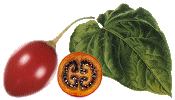
CULINARY INFO
Tamarilloes
"DISCLAIMER"
The information contained here is supplied for your interest only and further research may be required.
I have gathered it from many sources over many years. While I attempt to insure they are crossed referenced for accuracy,
I take no responsibility for mistakes - additions or corrections are welcomed.

Tamarillo
This information is reprinted courtesy of NZ Tamarillo Growers Assn Inc
P O Box 8327, Cherrywood, Tauranga
Ph: 021 504 658, Fax: 07 5700 542
Tamarillo Growers Website
Once a "lost food of the Incas", this exciting fruit has been developed, re-named and commercialised in New Zealand, to add a new food ingredient to the world’s table.
THE FRUIT'S HISTORY
The genus Cyphomandra is a member of the Solanaceae family, with the potato, tomato, eggplant and capsicum peppers being relatives of the tamarillo. There are at least 30 other species of Cyphomandra native to Central and South America, but none have attained the popularity and wide distribution of the tamarillo. Although native to the Andean region of Bolivia and northwest Argentina, the "wild" tamarillo seems to have all but disappeared from its native habitat.
The tamarillo (tree tomato, Cyphomandra betacea (Cav.) Sendt) has achieved significant commercial production in New Zealand, and is grown on a commercial scale in a few other countries (particularly Colombia and Ecuador, with smaller plantings in parts of Australia, California, Africa and Asia). In many other countries around the world it is popular as a home garden fruit.
Tamarillos were first introduced into New Zealand from Asia in the late 1800's. Only yellow and "purple" fruited strains were produced from the original introductions, but red types were developed in New Zealand during the 1920's by an Auckland nurseryman from seed sourced originally from South America. Other red strains, developed independently, appeared soon afterwards. Since then, continued re-selection of these original red strains by growers has led to the large, high-quality varieties that are now being grown commercially.
The commercial production of tamarillos in this country began on a small scale during the 1930's, but it was not until the supply of tropical fruits such as bananas, pineapples and citrus from overseas was severely restricted during World War II that any appreciable quantities were produced in an effort to have a locally grown fruit, high in vitamin C, readily available. Planted area, and thus fruit production, increased markedly with the horticultural boom of the 1970's.
The 1990's saw a growing professionalism among dedicated tamarillo growers with emphasis on biological pest controls and quality manangement systems. Some tamarillos continued to be grown as a supplementary cash crop. Demand for the fruit in the New Zealand remains strong due to widespread awareness, but tamarillos remain an exotic fruit in most export markets.
THE HISTORY OF THE NAME
This soft-wooded tree is a native to the Andes of Peru, Chile, Ecuador and Bolivia. It belongs to the potato family, Solanaceae and is listed among the lost foods of the Incas.
Although it is widespread in sub-tropical highlands it is not a commercial crop, generally being confined to home gardens. More than fifty years ago, horticulturists in New Zealand began breeding trials to develop the plant and soon a new crop entered production. Originally this fruit was known as tomate de arbol or "tree tomato", but the fruit of Cyphomandra betacea bore only a superficial resemblance to the common garden tomato, Lycopersicon esculentum. The flavour and general uses of the "tamarillo" are quite different from those of the ordinary tomato.
Confusion caused by the similar names became acute when fruit began to be exported from New Zealand, as new consumers were not aware of the significant differences between the two crops.
The problem fell on the New Zealand Tree Tomato Promotions Council, and one of its members, Mr. W. Thompson, to "make up" a new name. He cleverly combined a Maori (native Polynesian people of New Zealand) word "tama" which implies leadership, with a Spanish sounding name. The exact inspiration for "rillo" is not known. Some say Mr. Thompson first selected "tillo" but changed the t to an r making "rillo", which combined better with "tama". Others believe "amarillo" (Spanish word for yellow - the original fruit was yellow) was the source for "rillo". We shall never know for sure.
On 31 January 1967, after almost unanimous agreement among growers, and with the consent of what was then the New Zealand Department of Agriculture, the fruit's commercial name was officially changed from the "tree tomato" to "tamarillo". With a more exotic name, the "tamarillo" was introduced to export markets, carrying a name that respected both its origin and its country of commercialisation.
Since being introduced in New Zealand, the name "tamarillo" has been adopted in most of the world.
